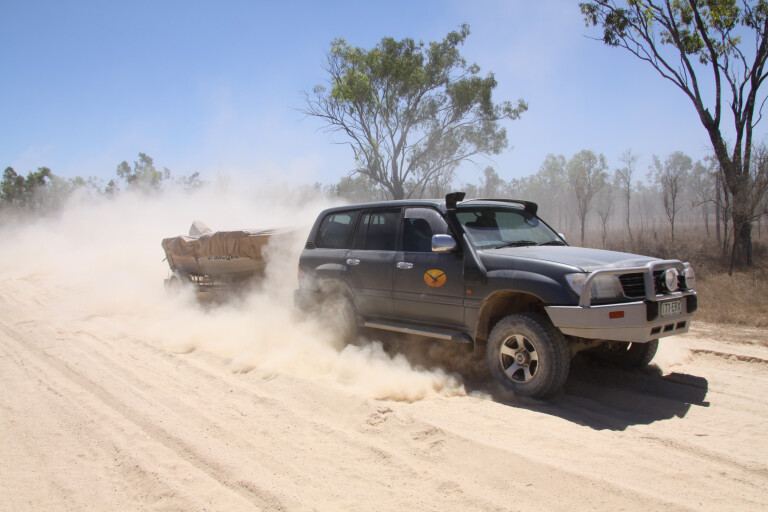
Fishing is Australia’s most popular outdoor activity, and many four-wheel enthusiasts are eager participants in the sport. The northern tropics have the best fishing in the world, all accessible to visitors and locals alike.
While you may know a lot about fishing in your backyard, the tropics are challenging to anglers on a first-time visit – a shame really, as any tropical excursion is worth the time and effort when it comes to all things fishing.
However, most know little about the north – what tackle to take, whether it’s worth car-topping a tinnie or towing a larger boat all the way to the tip of the Cape, Darwin, Broome or places in-between, and what about crocodiles that eat fishers for breakfast?
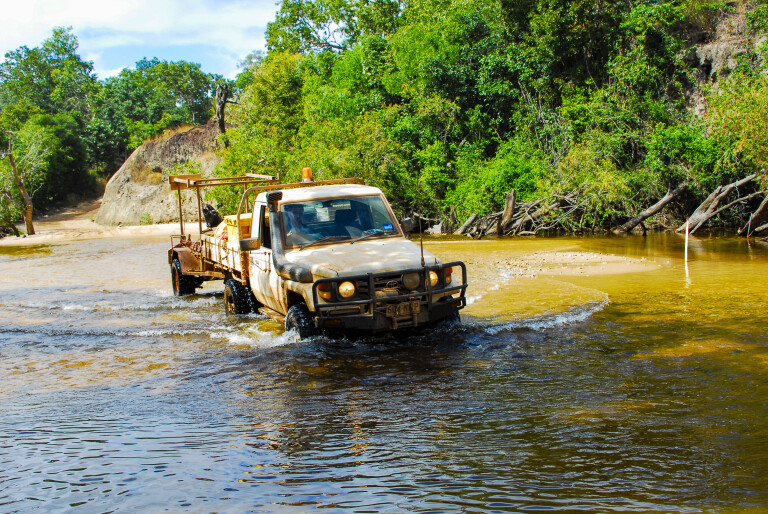
The answer to the second question is a big yes, provided you have the time to do so. Most keen southern-based off-roaders own a 4WD because of their love of fishing, but have no clue about tropical angling, apart from reading books, magazines and watching dream fishing action on TV.
The Savannah Way, which crosses the continent from Cairns to Broome, should have been called the ‘Barramundi Highway’, because it bisects some of the largest rivers in Australia, While ‘side tracks’ turn to even more remote places: the Cape York Peninsula, the Gulf country, Arnhem Land, Top End, Victoria River region and the vastness of the Kimberley. Fishing adventure country, all of it.
Over the last 60 years, I have been fortunate enough to fish almost every major river system between Townsville and Broome – from land and sea. There have been many changes across the whole northern coast since I first fished the Daintree River and caught my first barramundi back in 1959. I have been living in the tropics ever since, as the fishing, hunting, photography and off-road trips keep me forever young in the search of outdoor adventure.
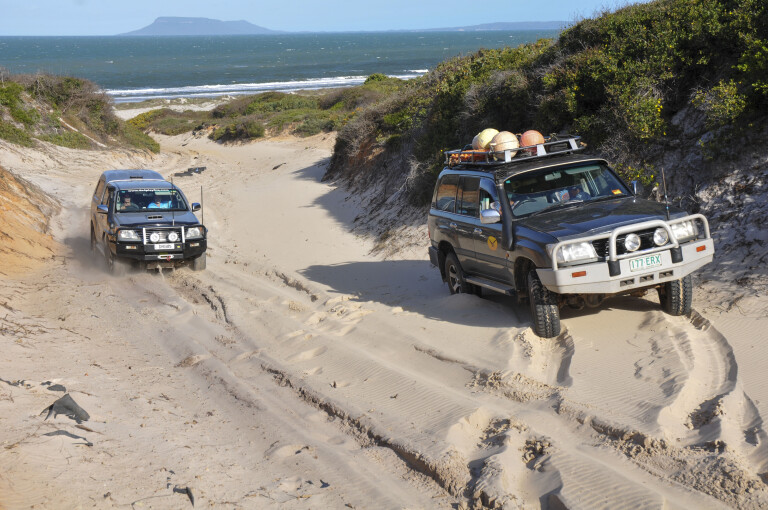
All of it is fishing frontier for the people who live up here and the hordes of visitors who head north in their thousands every dry season – grey nomads chasing the sun, urban-based off-roaders keen to tackle unbridled bush tracks, and anglers with a wish list that is topped with catching a ‘meteri barra’, what a metre-long barramundi is called up there. Yes, they grow that big and more.
Once you cross the Tropic of Capricorn on the East Coast, you are never too far away from stocked fishing impoundments, rivers, creeks and billabongs, all of which hold fish of several species. It matters naught if you are here to enjoy the sun, climate, fishing or just to explore this great land, but fishing may be the most attractive and motivating reason for your visit.
The northern freshwater waters are home to giant barramundi, saratoga, catfish, grunters, perches, cod and more, while the seas that lap these remote shores between Cairns and Broome are home to more than 30 sports and eating species – all attractive to anglers.
Fishing gear
You probably already know that all the best tropical fishers use expensive reels and rods, along with tackle boxes that require a trailer for transportation. Yes, they have all that and more and, should I ever sell my fishing tackle, I will be able to afford fish and chips from the takeaway for the rest of my days.
The truth is that any solid, quality fishing gear that you use at home will do for tropical fishing. Why waste money to buy a purpose ‘barramundi’ outfit some southern-based tackle salesperson will try and sell you when your own gear will do the trick.
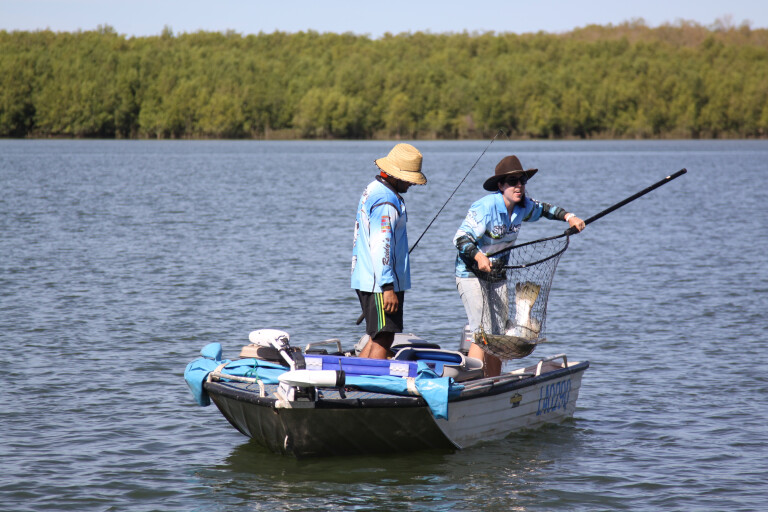
This applies to lures, hooks, sinkers and more. Buy barramundi lures in a northern tackle shop, along with some helpful advice from a savvy salesperson who knows about the local fish and where to catch them. You will find that tackle, especially lures and terminal tackle, is cheaper up here than in the south. Plus, they only sell tackle that catches local fish and is tough enough for the brutal assault from gear-smashing species and the titans of the tropical seas.
Basically, all you need to catch a fish is a length of line, a hook and bait. That was all we used decades ago, and many Indigenous people fish with a rudimentary monofilament line wound on a plastic spool. However, angling has evolved in to a sport that requires top gear for anyone who is half serious, meaning you need to move up the ranks in hustling up a feed with something better than the traditional hand spool.
I won’t go in to detail as to what gear is needed, because you are probably an angler anyway if you are reading this. I have yet to meet anyone who moved up here, or a casual fishing visitor, who was not aware of the gear needed, with many having their own robust fishing equipment more than capable of matching it with tropical species – think Murray cod and yellowbelly in freshwater, and kingfish, tuna and jewfish gear for saltwater in southern waters. If you have the fishing gear to catch those, you have the ideal gear needed for tropical fish.

If you are new to fishing, my recommendation is that you heed the advice of someone with local experience – don’t hand out the credit card to a southern counter jumper who has just convinced you to buy $1000 worth of fishing tackle because that is “what you need for a northern fishing trip”. Never mind that he has never been out of Melbourne.
Hiring a guide for the day is another good way to get to know the local scene and methods, especially some good solid advice on how to deal with crocodiles. Even as I write this, an angler was attacked by a four-metre croc north of Cooktown while fishing in shallow water. He stuck a knife in its head, and it let him go. He is recovering in the Cairns Base Hospital. Be careful out there and live longer.
This guide is not aimed at first timers, but for people who know about fishing and wish to gain some tropical experience. First timers rarely spend a great deal of money first up anyway because they may not like it, or they just want to get their kids involved in outdoor activities. Like I mentioned, most people who dream of tackling the tropical titans know about fishing and very few start off raw.
Tackle
The monofilament line on a plastic spool is the cheapest way to start fishing. You will see lines wound on plastic bottles and sticks used by many people – who can’t afford the latest Shimano and Sabre rod and a tackle box full of Reidy’s Lures – fishing from piers and jetties, seashores and elsewhere. Many parents start their kids off with a handline, but like us, kids don’t like to be left out and soon migrate to better gear, especially if they are keen.
Pre-spooled hand lines are cheap and easy to store when on the road. If you are a casual bait angler, it’s not to be written off, but a handline has its limitations – long-distance casting is out, and hooking yourself in the leg while twirling a large lure to get extra casting distance is an occupational hazard.
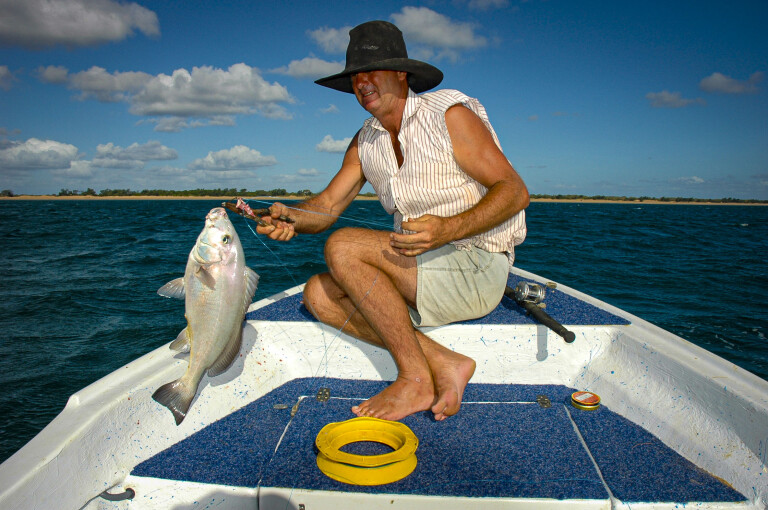
The tropics’ beaches and waterways are littered with discarded lines and spools of various kinds, especially about Indigenous communities. Leave them be, as the locals toss them in the bushes to be recovered and used on the next outing.
However, for most of us, a rod and reel are preferred, and having a good quality fishing outfit reel is paramount. Many visitors to the north hail from Victoria and the NSW coast – anglers who have cut their teeth on a long beach road armed with the ever-reliable Alvey sidecast reel, while others use spinning reels for their beach fishing. These beach outfits are entirely suited for tropical beach and estuary fishing, but totally unsuited for boat fishing or casting lures from under the gallery and tidal forest-clad streams.
You will need a few sinkers, 3/0 to 7/0 hooks, or 5/0 for all-round use, while a hand reel should be spooled with 30- to 50-pound breaking strain (lbbs) monofilament. You will also need 50-lbbs wire or braided wire leaders/traces for toothy fish as they bite braid and monofilament lines in half.
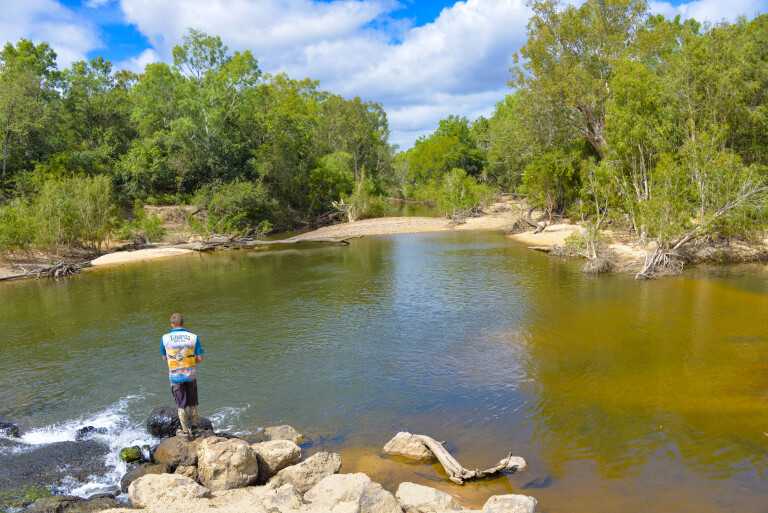
Most of us prefer monofilament leaders ranging from 50- to 80-lbbs, depending on what fish we are chasing. Mackerel for instance require a wire trace, while barramundi, who are armed with razor-sharp gill rakers, are stopped with a 50-lbbs monofilament leader. It’s preferred over wire, being more flexible – important when lure fishing.
Most northern anglers ignore beach fishing, even though tropical beaches produce fine fishing when the tides are right. Barramundi, threadfin and blue salmon, black jewfish, groper, cods, queenfish, trevally and mackerel are caught off many beaches, especially where sandy reaches meet rocky headlands. The same happens off the Cooktown, Seisia, Darwin, Wyndham and Broome wharves – the best land-based fishing platforms in the tropics. The southern beach outfit is entirely suited for tropical beaches, and many of us up here use one.
Spin outfits are popular, especially when casting light lures and rubbers, and for bait fishing. If you have a medium to salt to heavy freshwater outfit already, you have one that is used by many tropical anglers. Double-handed baitcasting rods ranging from 1.8 to 2.2m in length and matched with a Shimano ‘Curado’ reel spooled with 30kg braid line are ideal for bait fishing and lure casting.

That is the outfit of my own choice, a traditional bait casting outfit, as I love casting lures from boats and from foliage-covered riverbanks. Mated to a double-handled rod in the 1.8 to 2m range, such an outfit matches the aforementioned outfits, while accurate lure casting of various weights is unmatched.
The baitcast rig is a specialised one which has evolved from the handline as a purpose barramundi outfit. Hand lines, once the traditional weapon for barramundi fishing (when rubber thongs were turned in to ‘frogs’ and .303 shells in to barramundi lures, none which worked that well compared to modern lures – although the local pub’s bar fly will tell you otherwise) are not used by sports fishers.
Don’t believe the B/S from the bar flies because few have lived long enough to know about them, as the early 1970s saw the evolution of tropical sportfishing when modern lures became available.
Crustaceans
You may get lucky to find prawns schooling along beaches. Both the baitcast and drag bait nets are ideal for collecting a bucket of green fresh prawns for the barbie – or bait. You have not tasted fresh prawns until you catch your own. We also have cherabin, a freshwater prawn, in our northern freshwater streams and billabongs. They grow to a length of more than 80cm, including the nippers.
Cherabin are easily caught in shallows and deep holes in ‘yabbie’ or opera pots baited with fruit, meat, chicken and bait prawns. Red claw, a tasty freshwater lobster, are also attracted to these traps – most impoundments are alive with them. My own ‘best’ bait for cherabin pots are a couple of bait prawns placed in the bait pouch. Cherabin can’t ignore them.
Mud crabs are another tropical delight and are caught in crab pots, which are at their best when set from a boat in tidal estuaries. Pots can also be set from beaches and mangrove banks in estuaries, but beware of crocodiles when setting traps in both fresh and saltwater environments. They are attracted by the bait and the alarm signals of trapped crustaceans and fish in the pots. A crabber was killed by a crocodile at Cooktown some years back when he was checking his pot, only a stone’s throw from his local caravan park site. Like I said, you need eyes in the back of your head …

No tropical fishing guide is complete without mentioning crocodiles. We have two species, the Johnstone or freshwater crocodile, a relatively harmless fish eater that can grow to 3.5m, and the misnamed saltwater or estuarine crocodile, the largest predator in the world. It has been recorded at more than eight metres, but they average four metres these days – and growing.
Many live their entire life in the upper freshwater reaches of rivers, creeks, swamps and billabongs, thus don’t be fooled in to thinking you are safe. You can see now why they are misnamed, which gives a false impression of their habitat. Take great care in crocodile areas, ignore them and you will die. I am not joking, having lost a couple of mates to crocodiles and experienced close encounters myself in unguarded moments.
Tinnies rule
Years ago, the car-top tinnie ruled up here, but with more crocodiles than ever before, most resident anglers have upgraded their vessels to trailer boats. However, car-toppers endure, and many vehicles on the Cape carry one; though most never see water once their owners are told by the local roadhouse or pub ‘expert’ that crocodiles eat tinnies for breakfast – never mind that the ‘expert’ is probably doing a first-time ever trip and passing on the pub lore he has been conned with.
I have and still use 3.7m tinnies and have never had a problem with a crocodile attacking one; although, I did have a close call once when one almost pulled me over the side when I was dozing on the seat against the outboard. That was my fault, because I lost caution by ignoring the dangers that surrounded me.

Aluminium car-top tinnies are the best pick, being sturdy, hole-proof and light. The thickness of the sheeting indicates the strength, weight and rigidness of the vessel. Some tinnies are too light and tend to flex when on the water; others are too heavy and require a more powerful outboard, while also being too weighty to heave on to roof racks of vehicles and campers. Be aware that racks ‘secured’ on the vehicle roof-rim channels suffer from vibrations on corrugated roads that can shear the clamps off. The best are models that bolt on to the frame, like those on Toyota LandCruisers.
Tinnies come in two configurations: the flat-bottomed punt and the V-hull model. Both are excellent for transporting on either the vehicle roof rack, a trailer or camper, provided they are less than four metres and lightweight. The most popular is 3.7m long and weighs around 80kg. That may not sound like much, but launching, recovery from steep banks and loading requires two people, unless you have a purpose boat loader, which are available for both vehicle and camper/trailers. Tinnies can be dragged up steep banks with a winch, vehicle or by manpower.
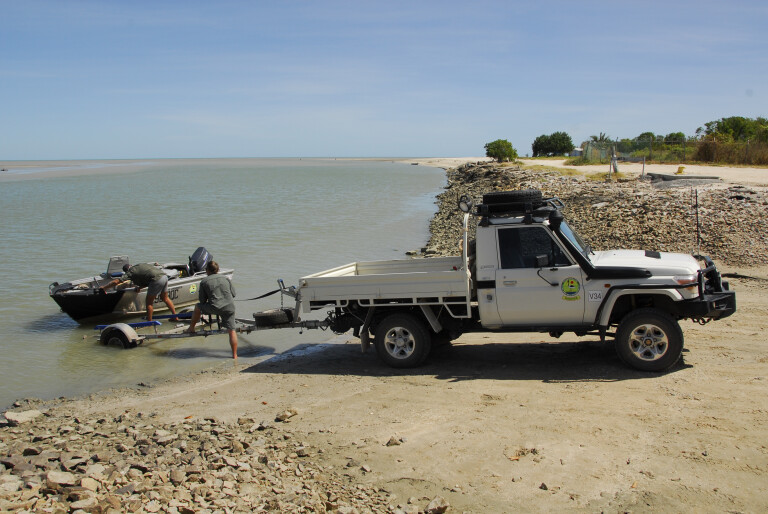
Tinnies are unsuitable on rough water that can be experienced on open impoundments, and they’re always a risk on large estuaries. Having said that, I have taken 3.7m tinnies to the offshore islands off Seisia on the tip of the Cape York, and to Arnhem Land in the NT, and never had a problem. However, such outings must be planned by ensuring that the weather does not blow up in the evening, with a 20-knot southwest or westerly wind.
The punt is especially at risk in rough water, as are lightweight V-bottomed tinnies. Most tinnies are suitable for two and even three people, depending on how heavy and large they are. There are some real heavyweights on the water, anglers who ‘train’ and spend more time drinking beer than fishing. I have seen tinnies with a 50mm freeboard loaded with heavyweights gulping down copious amounts of beer on the water … “Crocodiles? What crocodiles?”
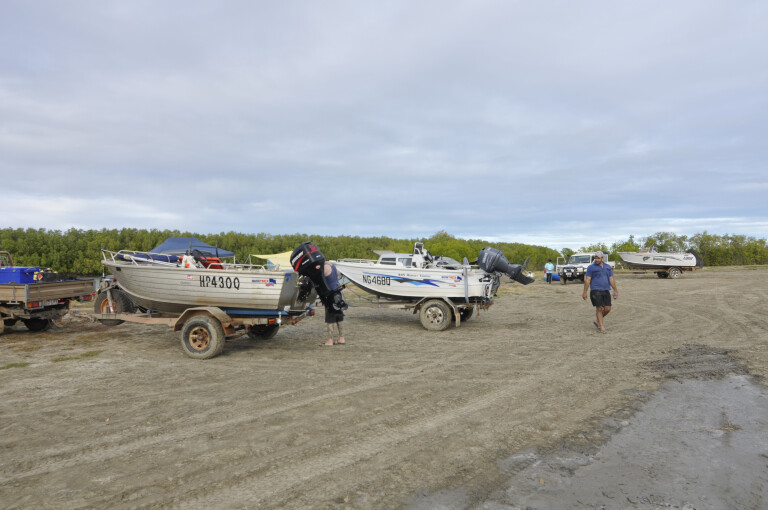
Tinnies are best powered by a suitably recommended horsepower outboard. Your dealer will advise you on that, while the compliance plate recommends the maximum horsepower size outboard for the vessel.
Safety gear must be carried, which includes either a paddle or oars, bailing bucket and lifejackets in protected water. Some states require occupants to always wear a lifejacket on board, which may be okay for the cooler southern climes, but not in the tropics where the chance of heat stroke and exhaustion is real when day temperatures are high and any extra ‘clothing’ does not help to keep cool. It’s a reason why copious amounts of liquid must be consumed, and that means water must be part of the load, not alcohol.
Boats to be wary of
Another vessel, one that sees little use by recreational anglers, is the blow-up ‘rubber ducky’. Similar to aluminium tinnies, they come in various sizes and are easily stored and transported in most 4WDs.
The larger ones are seaworthy, which, coupled with a soft ride, makes them attractive to some anglers. The disadvantage is that you are a sitting duck, being close to the water, and that the sides are subject to wave splashes, sticks, fish spines, knife punctures − and crocodile bites. Laugh not, it has happened. A ‘ducky’ can be left inflated and carried on a rack, like a tinnie; although if you have a compressor, they are easy and quick to pump up.
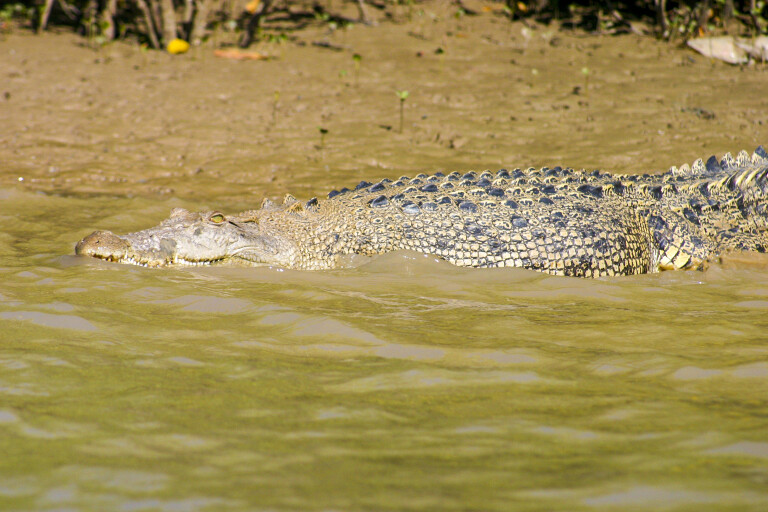
The ‘Porta-bote’ is a foldable vessel that is available in a couple of sizes. Similar to a surfboard when folded, it consists of several planks that when fitted together make up the boat. It can be powered by a small outboard, or an electric one, but having been in one on the crocodile-infested Daintree River I have no wish to promote it as a fishing platform for such rivers, estuaries and seashores, though it's suitable for protected lakes and river pools.
Power options
All fishing boats need power, even a Canadian canoe can be propelled with a small 2 to 4hp outboard or an electric one, but the above-mentioned tinnies require a bigger plant. If you have a dual-battery system in your 4WD, one which should be a slow-discharge battery, an electric outboard makes a lot of sense to potter about in the water.
But tinnies, both punts and V-shaped hulls, need something bigger to get about, though many anglers also use an electric motor for stealth fishing and as a spare. Most tinnies will take a 15hp outboard, but again I stress the importance of the recommended engine as per the compliance plate. A 10 to 15hp outboard is light enough for a fit person to carry, but when you move up to a 25 to 30hp motor, two strong people are needed.
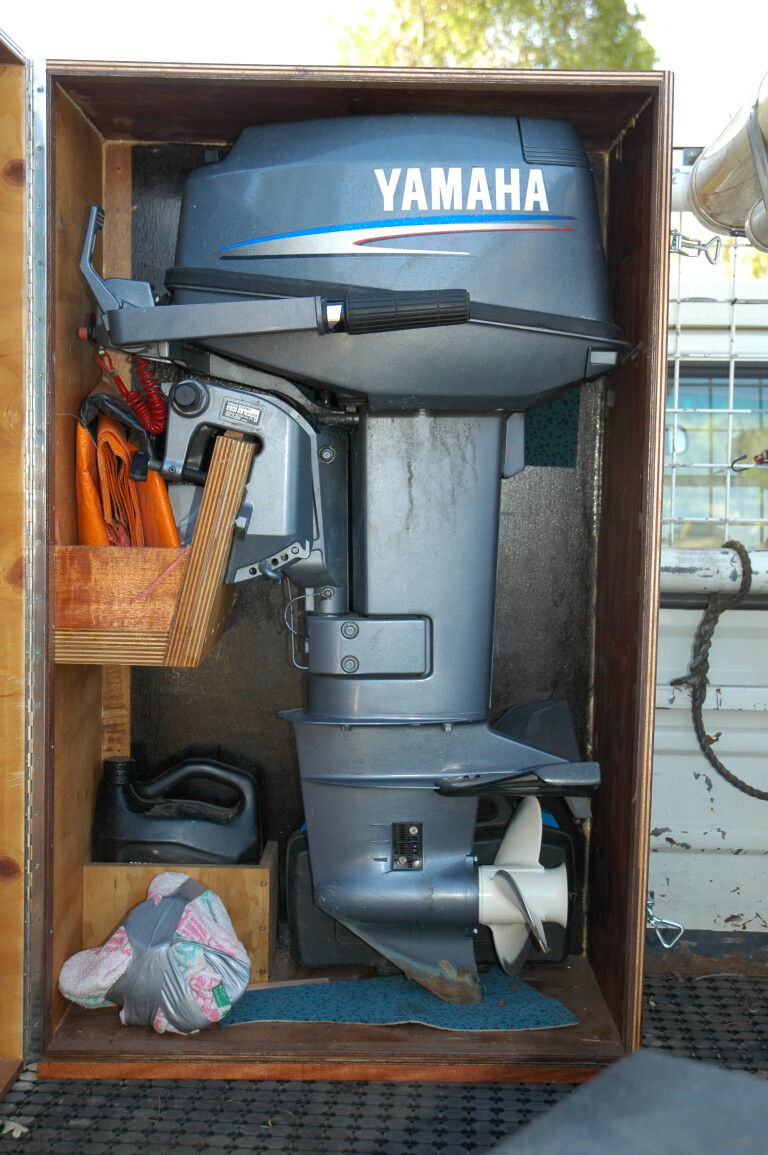
On the other hand, if you trailer your vessel, the outboard can be left on the transom, although I recommend you bolt it on to the transom, as clamp bolts have an annoying habit of coming loose on corrugated roads. I know of several cases where drivers have pulled up and discovered the outboard has gone missing or has been dragging behind the trailer for miles secured by its safety chain. A mate had one come loose from the transom when he hit a rock … it’s still in the mud of the East Alligator River.
Outboard leg supports are available, but most are useless on corrugated roads and will drop out, especially the spring-loaded models. A better support is to have a purpose Y-yoke made for you that secures on the trailer frame and holds the outboard leg at a 45-degree angle in the V-frame. Of course, all must be strapped down and checked each time you pull up.
Trailer boats must be secured on both the front and rear with straps, never rely on the winch rope and front secure point to hold the vessel on bad roads. If you are car-topping the tinnie, it’s best to carry outboards in an upright position; for instance, clamping it to the cabin guard in a trayback. If you must carry it on its side, place it on a thick padding to protect the cowl. Never carry it upside down.
Finding fish
The adage that fish can be caught anywhere up north is incorrect. Like elsewhere, you must work for your fish. Yes, some people get lucky, like the bloke who walked on to the Cooktown wharf, cast a lure off it and caught an 18kg Spanish mackerel. Never mind that half the town’s population has spent the whole morning trying to catch a fish … and failed.
Another bloke walked on to Cahills Crossing in Kakadu and lucked a metre-long barramundi on his second cast. By the time he landed it, half the crocodile population in the park were after his catch. That stuff happens, but mostly when you pull up somewhere on a likely looking spot where you have no idea how many others before you got lucky or failed. Thus, it’s best to find your own fishing spot away from popular places, study the tides and pick the weather, or camp beside a long freshwater reach. And never ignore beaches and headlands.
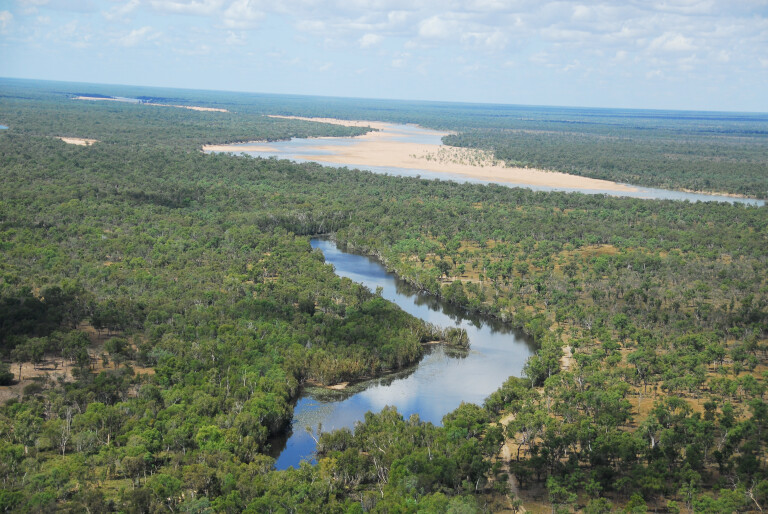
Fish, especially barramundi, are notoriously difficult to catch when the weather is cool and the water cold, which is what happens in our dry season when temperatures plummet and fish suffer from ‘lockjaw’ and won’t bite. So, it stands to reason that catching a feed in our northern winter is a challenge for casual visitors.
Fish move about a lot and tend to move with tides up and down estuaries and along beaches. If you have a lure or bait in when a school passes, you will be in luck, otherwise it’s a long wait between traffic. The top spots are off headlands, rocky foreshores and snags.
The best fishing is generally from a boat, because it allows you to get in close to target the fishy places. Colour changes in the current also hold fish because bait uses dirty water to hide in. Predators know this and will attack any lure they come across.
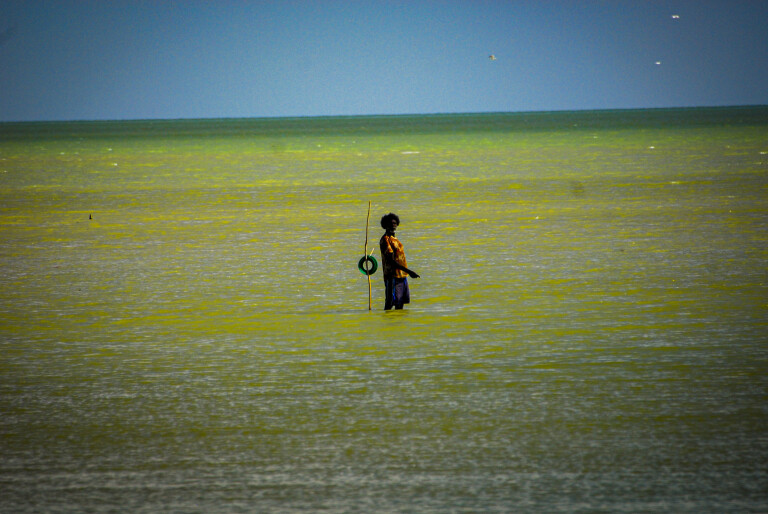
Beach fishing is largely ignored in the tropics by locals, but it can be rewarding, especially on the turn of the tides when fish and bait become active. The best spots are shallow gutters, rocks and headlands where both lure and bait fishing can be done. Bream, flathead, barramundi, salmon, jewfish, queenfish, catfish and trevallies all hunt prey and forage along beaches by working with an incoming flood tide.
You will need a bait net to catch mullet and other baitfish. They gather in tight bait balls in the shallows or shelter in gutters. Both frozen fish and bait prawns are available from tackle outlets and many service stations, in case you don’t want to risk a face-to-face encounter with a crocodile while knee-deep in water ‘armed’ with a bait net. It’s always a risk and one you must be aware of.
Dangerous critters
During the tropical build-up season (the prelude to the monsoon) from October onwards, box and Irukandji jellyfish, the deadliest creatures in the world, swarm on to the tropical beaches. If you contact one, or the tentacles, and are stung, you may die if help is not available. Stay out of the water and check the cast net for tentacles.

Crocodiles are also more active during the build-up. Carry a couple of litres of vinegar, the recognised first-aid treatment for box jellyfish. The Irukandji sting is similar to a wasp sting and may not be immediately noticed until hours later. Yes, tropical fishing is adventurous, including the lowly task of bait collecting.
Another thing, when collecting bait with either a cast or drag net, unwanted fish like the deadly stonefish, stingrays, sawfish, sharks and even small crocodiles are sometimes caught in bait nets.
Fun, huh? But such things are rare and the stuff that legends are made from. Just be aware of the bity things and stay alive.
Cooking and taking care of fish
Fish go off rapidly when the humidity and sun are high, thus you need to ensure that the fish you catch stay fresh. This is best done by cutting its throat and bleeding it, before storing it on ice or in the car fridge for dinner. You can also make up an ice-slurry by mixing 20 percent of seawater with one percent of ice. This provides an instant ‘freeze’ and is ideal when ice supplies are low.
Humid conditions cause gut bacteria to spread rapidly when a fish dies. Leaving fish in the bottom of a tinnie exposed in the sun ‘cooks’ it with solar radiation and spreads bacteria. If eaten, it may kill you. A damp hessian bag is okay for a short period if you have no ice. A popular method of keeping fish alive is to tether them behind the tinnie, but it’s illegal in some parts across the north and will incur the wrath of the RSPCA.
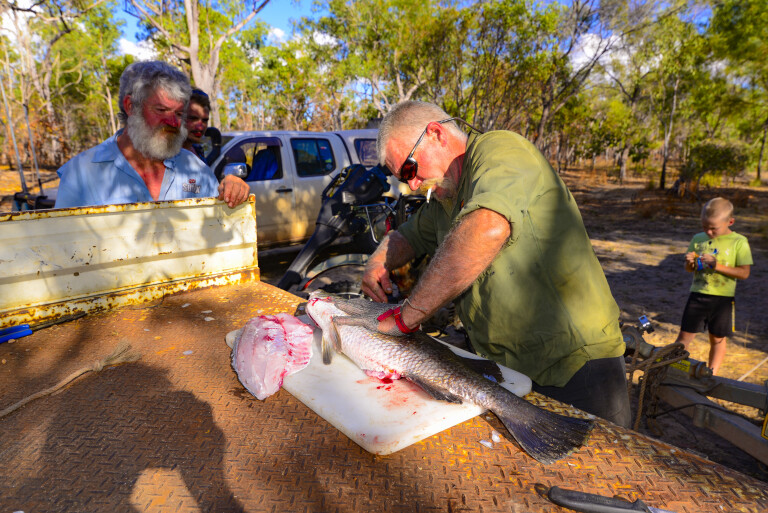
Check the laws regarding filleting fish as it’s illegal to do so until you are back on land in some States and Territories. You may also be required to keep the skin on the fillet. More importantly, there are bag limits and size restrictions to adhere to, so check States and Territory fishing regulations before fishing.
Fresh fish is the best bush tucker you can eat, and the top part is cooking it and enjoying a great meal with drinks of choice. Apart from toad fish, freshwater bullrout and stonefish, we don’t have any poisonous fish, though ciguatera poisoning is a problem from regularly dining on some tropical sea fishes, with Chinaman fish, big Spanish mackerel and coral trout being the most suspect. It’s a local issue and most of us release large species to avoid risks.
Some freshwater fish such as saratoga and tarpon are best released as they are riddled with bones and are not that tasty anyway. Catfish are frowned at by purists, but the fact remains they are good bush tucker. I have seen Aboriginal’s swap barramundi for catfish on the infamous East Alligator Crossing. They cook them whole on a campfire. Catfish make great fish cakes by part-boiling the fillets first.

Fish are simple to cook, but most bush ‘cooks’ stuff tasty fillets up by under- and over-cooking or adding so many condiments to the point that it does not taste like fish anymore. All you need is little flour to stop the meat from sticking, toss it on a hot barbecue plate, turn over once and it’s done. Freshwater fish benefit from a little salt and pepper, which is best mixed with the flour dusting.
I use a mix of virgin olive oil and butter on the plate, or in a frypan, on high heat, for best taste. Coals are ideal for cooking and most fillets can be cooked in less than 10 minutes. When baking fillets; place a lid or even al-foil over them for the first turn. This ‘steams’ the flesh and holds the juices. Remove the cover when the fillets are turned for the final cooking stage. Jab a knife point in the flesh. If it goes in without resistance, the fish is cooked to perfection.
Another method is to cook fillets or whole fish wrapped in layers of al-foil, along with vegetables, salt and pepper. Some people spoil good fish by adding chillies – your choice. Hot fish is not everyone’s cup of tea …
The al-foil-wrapped fish can be cooked in campfire ashes, frypan or on a barbecue plate. Again, it should only be turned over once. When cooking whole fish, only remove the gut and don’t scale it. You can add a whole list of condiments to cooked fish, but apart from salt, pepper and a squeeze of fresh lemon juice, fish is at its best when cooked and eaten in a simple way.

COMMENTS